Did you know that while your pillow cover does protect your pillow from dirt, oils, and sweat, it’s not actually 100% protected? It’s actually super important to wash your pillows! That’s what you sleep on! Here is the best way how to wash pillows in the washing machine without ruining them.
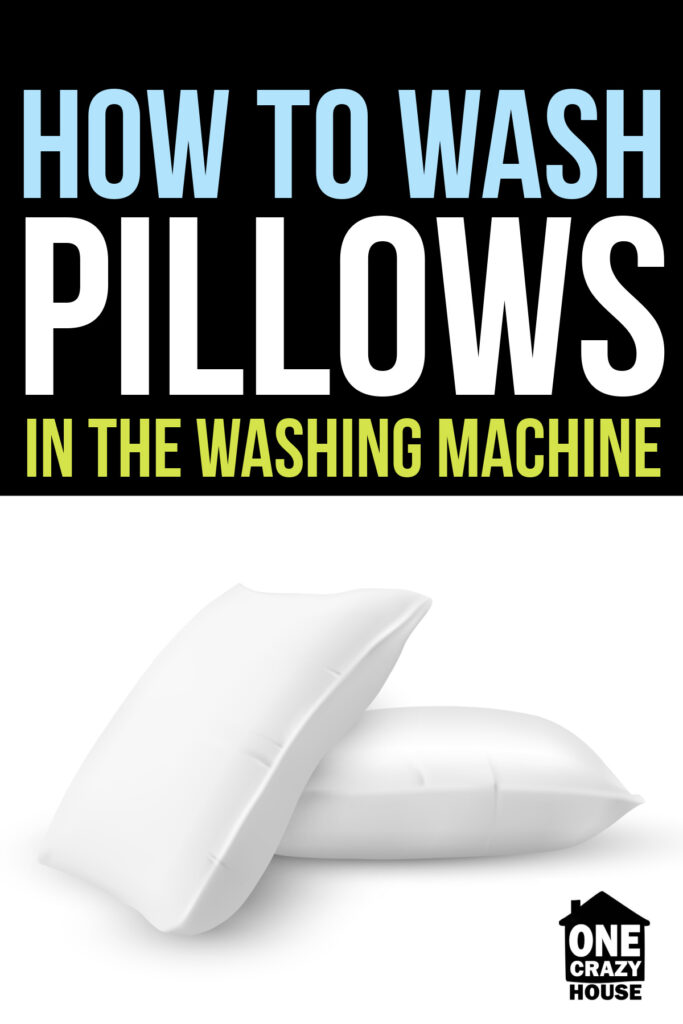
Over time, natural oils from your body as well as sweat and other gunk will seep into your pillows and get them dirty. This can cause a yellow discoloration in the fabric of your pillows, leave a few stains and be unsightly. Kinda gross, right?
Even with a pillow protector, unwashed polyester, memory foam pillows, latex pillows or synthetic pillows can breed dust mites and bacteria over time and cause issues for allergy and asthma sufferers. So important to wash your pillows for your health and skin you all.
BUT, you should know that you can actually clean your pillows and revive them instead of tossing and buying new ones! You guys know I’m all about frugal- even when it comes to repurposing those pillowcases.
In this post, I am going to share the most effective way to wash pillows: in the washing machine!
How to Wash Pillows, the Simple Way
Before I share step by step how to wash your pillows, here are a few simple pillow washing tips I recommend looking!
1. Check the care label tags on your pillows to see if they are machine washable.
In most cases, you can safely wash synthetic and down pillows but you never know! I would still double-check on how if they are able to be cleaned in this way. It will tell you exactly how to do the washing and drying.
When washing pillows in a washing machine, there are several types of label tags you should pay attention to. These tags provide important information about how the pillow should be cleaned to prevent damage.
-
Materials/Fillings: The tag will often list the materials that the pillow is filled with, such as down, synthetic fibers, or foam. Different fillings require different care, and some might not be suitable for machine washing at all. For example, memory foam or latex pillows are typically not machine-washable.
-
Washing Instructions: The care label should indicate whether the pillow is machine washable or not. If it is, it will usually include specific instructions, such as the recommended water temperature, cycle type (delicate, normal, etc.), and whether bleach can be used.
-
Drying Instructions: This tells you how to dry the pillow after washing. Some pillows can be machine dried while others need to be air dried. Certain materials might require low heat, while others might tolerate high heat.
-
Warnings: If there are any special warnings or precautions, they will usually be included on the label. These could include instructions like “do not iron”, “only use non-chlorine bleach”, or “dry clean only”.
In general, it’s always a good idea to follow t
he care instructions on the pillow’s label. If the label is missing or faded beyond legibility, you might want to consider replacing the pillow, or proceed with washing on a delicate cycle with a mild detergent, then air-drying, to be safe. Better be safe than sorry.
2. Make sure your pillows are a good machine fit.
Double-check and make sure how many pillows will fit in your washing machine. With our washing machine, I can fit two pillows in a spin cycle pretty easily, and so I just wash two at a time.
The size of pillows that can fit in your washing machine will depend on the capacity of the machine. Here’s a general guideline on how to check if your pillows are a suitable size:
-
Size of the Washing Machine: Standard top-loading machines without an agitator (the large spindle found commonly in the middle of the drum) can typically fit around two standard-size pillows. Front-loading machines can typically fit two standard-size pillows as well. A high-capacity washing machine might be able to fit more. Keep in mind that you don’t want to overstuff your machine, as this can throw off the balance during the spin cycle and also prevent your pillows from being washed thoroughly.
-
Check the Pillow Size: Measure the size of your pillows. Standard pillows are typically 20 by 26 inches. If your pillows are significantly larger, such as king-size pillows, you may only be able to wash one at a time, even in a large-capacity machine.
-
Test Fit: You can try placing your pillows in the washing machine without any water or detergent. The pillows should fit comfortably and there should be a bit of space around them. If you have to force the pillows in, they are too large.
Remember that washing more than one pillow at a time can help balance the load during the spin cycle, preventing damage to your machine. If your pillows are too large to fit in your washing machine, you might want to consider taking them to a laundromat with commercial-sized machines, or washing them by hand if the care label allows it.
3. Don’t overstuff your washing machine with pillows!
DO NOT just stuff what you can and call it a day. You should not wash more than two pillows at a time because there won’t be enough space for the pillow to move freely. The pillows will probably not be cleaned and you might break something.
Also, I don’t know about you, but washing machines are expensive and I like to save my $$$.
4. Remember to remove your non-white pillow cover.
Remember to remove the pillow cover so your pillow can be treated properly. Not only that, it would be a disaster to ruin your color pillow cover with bleach. It’s like spot cleaning and you’ll end up with LOTS of spots. Not nice. I know! because it happened to me once. Oh, and here are a few more reasons why you might not want to leave on that pillow case:
-
Thorough Cleaning: Pillowcases can be barri
-
ers that prevent the pillow from getting thoroughly cleaned. Washing them separately ensures that both the pillow and the pillowcase get a thorough clean.
-
Different Care Instructions: Pillows and pillowcases often have different care instructions. Pillowcases, particularly decorative ones, might need a gentler wash or have different temperature requirements than the pillow itself.
-
Prevent Damage: Washing pillows and pillowcases together might result in damage. For instance, buttons, zippers, or other elements on a pillowcase could potentially harm the pillow during the wash.
-
Washing Efficiency: Pillowcases and pillows have different sizes and thicknesses. Washing them separately will allow each to move freely in the washing machine, helping to ensure an effective wash.
Therefore, it’s generally a good idea to remove pillowcases and wash them separately from the pillows themselves.
5. You CAN throw your pillow cases into the same load.
Chances are your pillow covers also need a makeover, and they don’t take that much space to wash in the same load.
AND only if they are white and washable, you might as well get them nice and clean with a mild soap solution, killing two birds in one stone.
Don’t be afraid to throw them in!
6. Wash two pillows at a time or throw in some towels.
You should wash two pillows at a time to keep the washing machine balance. The washing machine is going to work harder when it’s unbalanced. You don’t want any potential damage. If you only have one pillow to wash, you can throw in some white towels or mattress protectors to help with the balance. Here are some washing machine balancing strategies:
-
Wash Multiple Pillows: If your machine has enough space, it’s best to wash two pillows at a time. This is because the pillows can balance each other out during the wash and spin cycles. Place them opposite each other in the drum.
-
Add Towels: If you only have one pillow to wash, or if your pillows are too large to wash two at a time, you can use towels to balance out the load. Add one or two towels (depending on their size) into the machine along with your pillow. It’s better to distribute these towels evenly in the drum to maintain balance.
-
Reposition if Necessary: After filling the machine, spin the drum manually to ensure it feels balanced. If it doesn’t, reposition the items until it does.
Remember to use towels of similar colors to your pillow to avoid any dye transfer. This is especially important if you’re washing the pillow or towels for the first time, as some items can release dye in the first few washes. BUT remember not to overload it.
7. Turn your pillow from yellow to white e
venly.
Dissolve the cleaning solution completely before adding in the pillows, so you know it’s evenly distributed. Don’t sprinkle clumps of soap won’t do the trick. You can mix the solution together before pouring it into the washing machine or if you have a top-loading washing machine, make sure to manually turn the agitator a few times to give it a swirl.
For products and exact measurements, continue to read and follow the instructions below to turn your pillow clean and white.
How To Properly Wash Pillows In The Washing Machine And Dry It
Here is a step-by-step tutorial on how to get fluffy and clean pillows by washing them in your top or front-loading washing machine, and how to properly dry them.
1. Get the products you need to wash your pillows
Here are the supplies and exact measurements you need. And these products you don’t have to go buy because you might already have them at home.
- 1/2 cup laundry detergent (Whatever detergent you use works. I generally use Tide.)
- 1/2 cup baking soda (substitute with Borax if necessary)
- 1 cup bleach
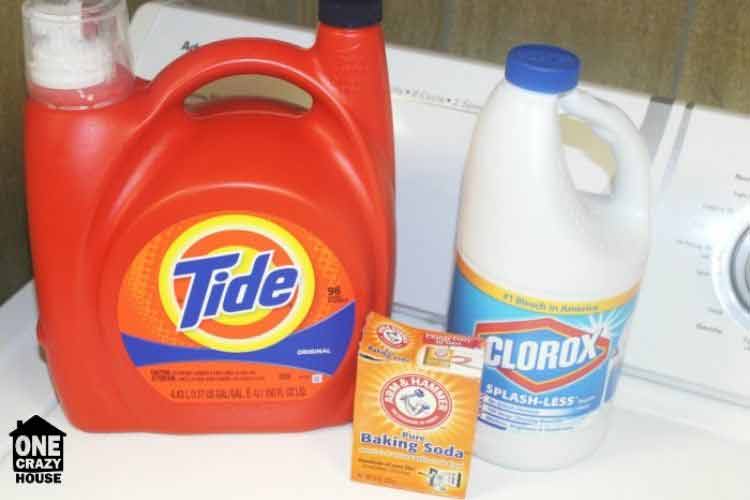
2. Follow these instructions for the TOP-LOADING washing machine
- As previously stated, make sure the tags say it is machine washable. You don’t want to ruin your pillows. Most down and synthetics are safe to be washed.
- Start running your washing machine on the longest cycle using hot water.
- Add in your laundry detergent soap, baking soda, and bleach, and then place two pillows in the washer. It usually is best to select a gentle cycle. (Add in an extra rinse cycle if you prefer)
- After your washer fills up with hot or warm water (lukewarm water is also a good choice), turn it off and let your pillows soak for 1 hour. You can go push the pillows down and move them once during the wait time if you want to help make sure that all areas of the pillow get treated.
- After the hour duration is up, run the rest of the washing cycle like you normally would.
- Toss pillows in the dryer (see setting preference below) to get them dry and avoid dampness. Be careful and determine if your pillows can be put under direct sunlight for extra drying.
Note: I generally wash my pillows about once a month to every other month. You can add a washing pillow to your cleaning routine and do it as often as you would like.
3. Follow these instructions for the FRONT-LOADING washing machine
- As previously stated, make sure the tags say it is machine washable. You don’t want to ruin your pillows. Most down and synthetics are safe to be washed.
- Add in your laundry detergent soap, baking soda, and bleach, and then place two pillows in the washer. It usually is best to select a gentle cycle.
- Start running your washing machine on the longest cycle using hot water.
- After your washer fills up with hot water, turn it off and let your pillows soak for 1 hour. Since the machine is front-loading, you can’t open the door and move the pillows around and move them to remove the odors like you could with a top-loading washing machine. (see Tip below for alternative method)
- After the hour duration is up, run the rest of the washing cycle like you normally would.
- Toss pillows in the dryer (see setting preference below) to get them dry.
Tip: You can soak the pillow in the bathtub with all the cleaning products with hot water for one hour before transferring it to the washing machine. So that you can rotate them and ensure all areas of the pillows are treated and turn white evenly.
3. How To Properly Dry Washed Clean Pillows In The Dryer
After you have washed all your pillows, it’s time to start drying them. The
drying process is essential in removing excessive moisture and make your pillows fluffy. Here are some tips you can do without using the vacuum.
Again, make sure to read the label first for cleaning instruction and that the tag says tumble dry. It helps to learn how to read laundry symbols!! For example, unless specified, a foam pillow can’t be placed in a dryer. The heat from the dryer can melt the memory foam.
Follow these instructions for the specific type of pillow filling:
- If you have synthetic or cotton pillows, make sure to set the dryer on “low heat” settings.
- For down pillows, set your dry on a “fluff” or “air dry” setting to keep them plump and light.
Make sure the pillows are dried thoroughly. You can speed up the drying process by throwing in some dry towels, and check every 15 minutes or so and turn the pillows in case it gets stuck in one spot.
If you have a tennis ball or two, or wool dryer balls, you can tumble them in to help keep your pillows fluffy and not have the filling piling up in one area of the pillow. And they can help speed up the drying process and you get them done quicker.
Tip: If you are using a tennis ball, put it inside a sock to prevent the color from bleeding. You can also wash to test see if the tennis ball is colorfast or wash it a few times first to run out the dye.
Don’t Throw Out Your Pillows – You Can Easily Wash Them!
See how simple it is to clean pillows? I have been doing this for years and I can’t complain. Using this method to wash your pillows will help you get rid of the dirt, grime, dust, and sweat that seeps into your pillows over time.
-
Cost Savings: High-quality pillows can be expensive. Regularly washing your pillows can extend their lifespan and save you money in the long run.
-
Environmental Considerations: The production of new pillows uses resources and energy, and old pillows often end up in landfills. By washing and reusing your pillows, you can help to reduce your environmental impact.
-
Comfort: If you’ve found a pillow that you find particularly comfortable, it may be hard to find an exact replacement. Maintaining your existing pillow through regular washing ensures you keep that comfort level.
-
Allergen Reduction: Pillows can collect dust mites, dead skin cells, and other allergens over time. Regular washing can help to reduce these allergens, leading to a cleaner sleeping environment and potentially reducing allergy symptoms.
-
Hygiene: Over time, pillows can also absorb sweat, oils, and saliva. Regular washing helps to keep your pillows clean and hygienic.
-
Aesthetic Reasons: Stains or odors on pillows can be unsightly and unpleasant. Washing your pillows can help to remove these issues without the need for replacement.
However, keep in mind that even with regular washing, pillows do not last forever. It’s recommended to replace pillows every 1-2 years, depending on the type and quality of the pillow. Over time, they can lose their support and structure, which can lead to discomfort and poor sleep. So, while washing is important, also consider the overall condition of your pillows and replace them when necessary.
Do you wash your pillows or do you replace them?
Love this clean pillow hack? Check Out These Other Cleaning Posts
- How To Clean Microwaves: 5 Easy No-Scrub Methods
- 17 Genius Uses For Dawn Dish Soap Every Mom Needs
- 3 Natural Coffee Maker Cleaner Hacks For Great Tasting Coffee
- 16 Amazing Murphy’s Oil Soap Tips and Hacks You Need
- 17 Must-Try Toothpaste Uses For Your Home
Pin How to Wash Pillows for Later Use
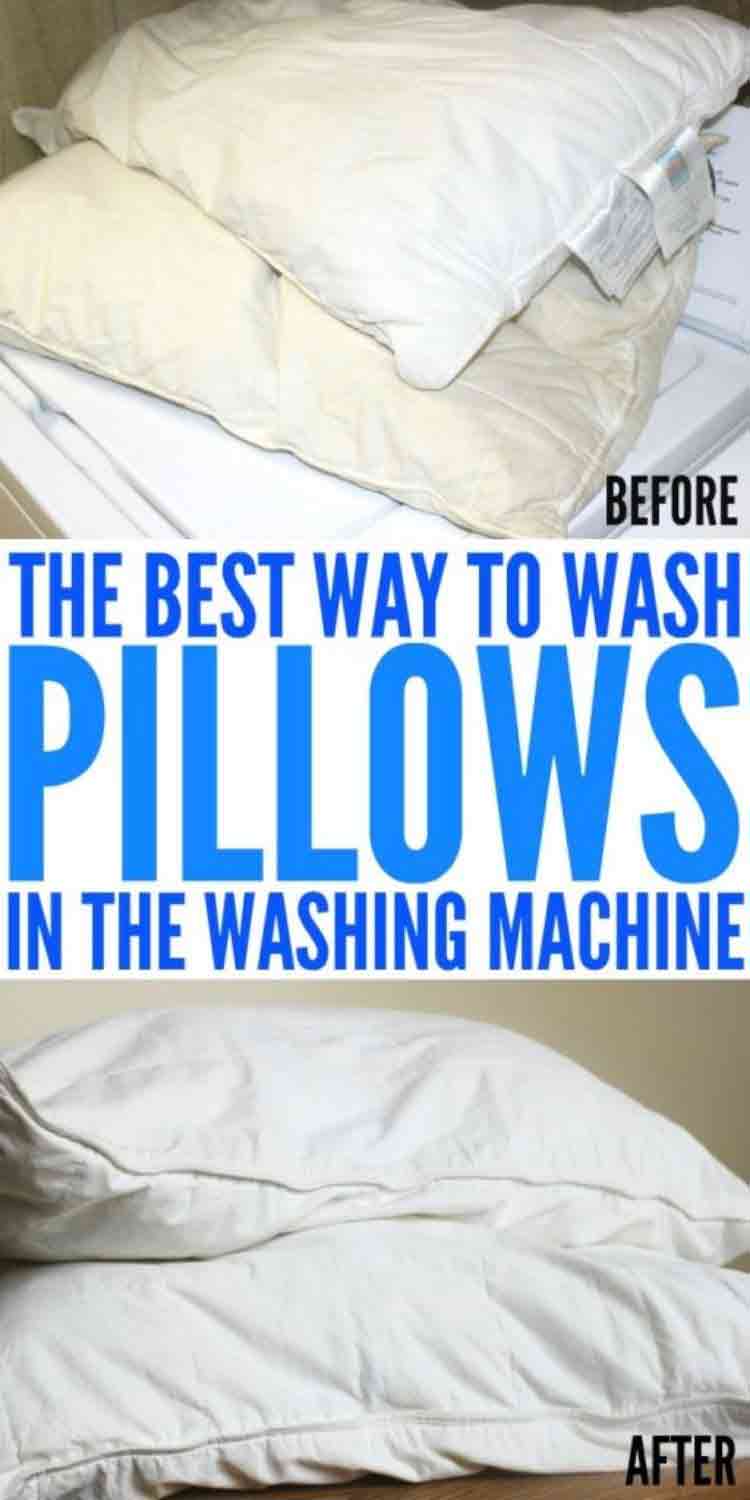
Which pillow-cleaning tip works the best for you?

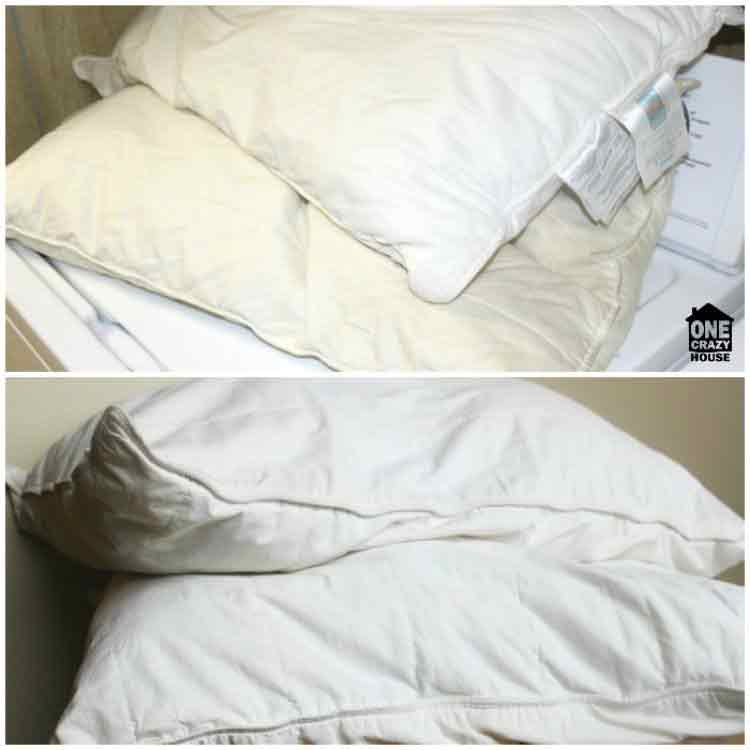




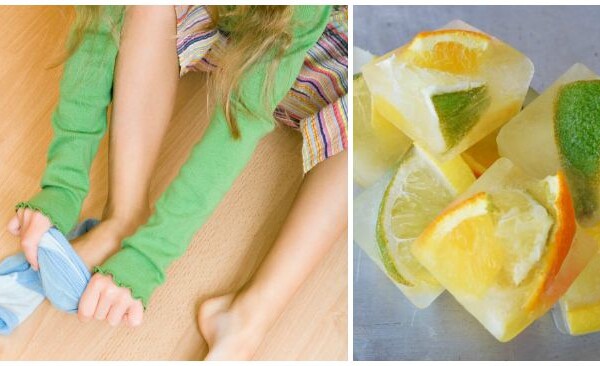




0